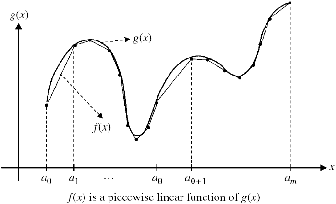- a feasibility region that is given by the union of two disjoint polytopes that is: {x | Ax ≤ b ∨ Cx ≤ d}.
- the logical conditions on binary variables xi, i=1,…,4:
- ¬ x1 ∨ x2 ∨ x3
- x1 ∧ x2
- (x1∧ x2) ⇒ (x3∧ x4)
- a piecewisely linearized general nonlinear function g(x) of a single
variable x. Let g(x) be continuous and x be within the interval
[a0,am]. Let f(x) be the piecewise linear function of g(x),
where the interval [a0,am] is partitioned into m small intervals
via the break points [a0,a1,…,_m], where a0 < a1 < …
< am as shown in Figure 1.

Figure 1: A general nonlinear function g(x) and its piecewise linearization f(x)
- Give a CP model for the problem
- Give at least one redundant constraints
- Describe a possible branching rule
- Identify all possible symmetries
- [a)] the use of global constraints (full, partial, no use);
- the consistency level (look at the documentation of the global constraints to understand how to declare this);
- a few different choices for branching
Each card is characterized by the power it requires. Each rack model is characterized by the maximal power it can supply, its number of connectors, and its price. The problem is to decide how many of the available racks are actually needed, and which rack is of which rack model model such that
- every card is plugged into one rack
- the total power demand and the number of connectors required by the cards does not exceed that available for a rack
- the total price is minimized.
- [a)] model the problem in CP;
- implement the model in gecode-python;
- compare on the basis of time, number of nodes and number of failures different choices for branching ;
- symmetry breaking avoids searching for solutions that are obtained by simple permutation of previously visited states. In this specific problem the symmetry is broken by imposing an ordering in the prices of the four items. Check if the contribution of this breaking symmetry is relevant;
- observe that 711 is has a prime factor 79. How could you use this fact in the CP model?
- Let a, b, c, d be the cost of the four items. Compare two models that decomposes the multiplication constraint abcd=711 into 1) ab=t1, cd=t2, t1t2=711; 2) ab=t1, t1c=t2, t2d=711.